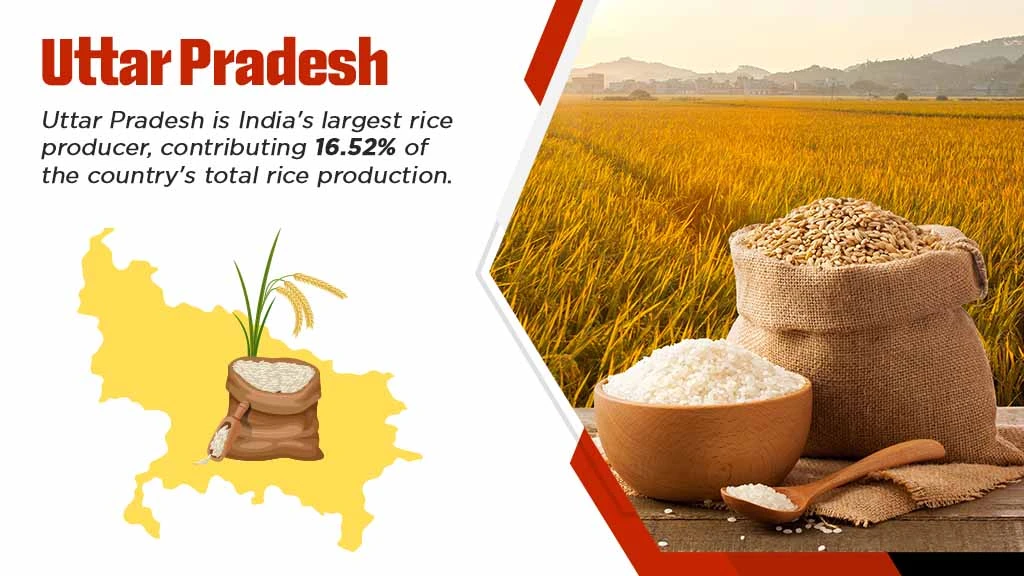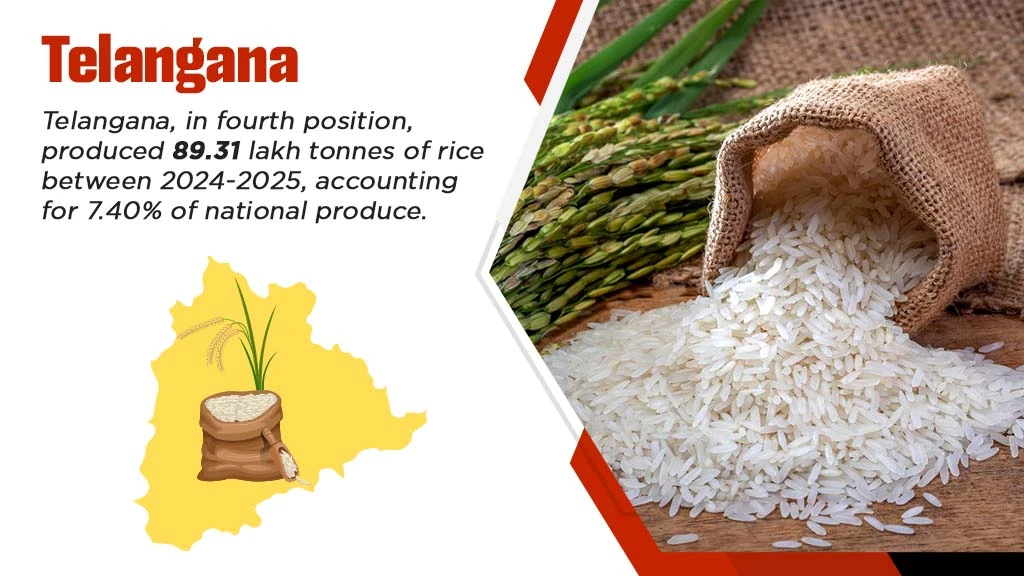Top 5 Rice Producing States in India 2025

Table of Content
Introduction
Rice is one of the most essential food grains in India, cultivated extensively across the country. Its cultivation spans from the Gangetic plains in the north to the coastal regions in the south. It is a staple food in many Indian households, holding both economical and religious significance. In India, rice farming typically begins with the onset of the monsoon season, that is from months of June to September. This period is also known as the Kharif season which is ideal for rice cultivation.
India’s favourable climate allows the growth of different rice varieties. Some of the major rice varieties grown in India include Basmati, Mogra, Jasmine, Aizon, Ambemohar, Chakhao, Dubraj, Burma Black, Indrayani, Kolam, and many others. With the technological advancement in agriculture sector, the use of modern tractors and farming implements such as Rice Transplanters have helped increase rice productivity significantly.
What are the Top 5 Rice Producing States in India?
We have listed the top 5 rice-producing states in India according to the Department of Agriculture and Farmers Welfare's 2nd Advance Estimates report for 2024-2025.
Uttar Pradesh

Uttar Pradesh is the top rice-producing state in India. The state contributes about 16.52% of the nation's rice output. In year 2024-25, the state was able to produce around 199.40 lakh tonnes of rice with an average yield of 2760 kg per hectare.
Since the state has the ideal climatic condition for rice cultivation, various rice various type of rice are available, such as Basmati, Adamchini, Tulsi Manjari, and Sona Chuda. A special variety of rice that only grows in the state is Kalanamak rice. This rice variety is mainly cultivated in Siddharthnagar and nearby bordering areas of Nepal. It known specially prized for its unique taste and aroma. Some other rice-producing districts include Bahraich, Ballia, Gonda, Azaampur, Mirzapur, and Lakhimpur Kheri.
Punjab

Punjab is also known as 'the rice bowl of India’ due to the state’s significant contribution to the country's overall rice production. Punjab is the second largest rice producer in India, making up about 11.80% of the national output. Between 2024-2025, The state was able to harvest 142.45 lakh tonnes of rice, achieving a yield of 4393 kg per hectare, which is the highest compared to other states.
Punjab is specially known for producing high-quality Basmati rice, which is mainly grown for the purpose of foreign export. Notable Basmati varieties include Pusa Basmati 1121 and Pusa Basmati 1509, along with non-basmati types like PR 126, PR 121, and PR 106. These varieties are grown in various regions of Punjab, including Barnala, Ferozepur, Fazilka, Sangrur, Tarn Taran, Patiala, Moga, Mansa, Kapurthala, and Faridkot.
West Bengal

Rice is considered a staple food in West Bengal due to the state’s favourable climatic conditions and plenty of water resources. These two factors contribute significantly to high rice yield in the state. The state ranks third among the top rice producing states in India. Between 2024-2025, it was responsible for 10.04% of the country's total rice production output, which was around 121.18 lakh ton, with an average yield of 2865 kg/hectare. The state grows high-yielding varieties of rice such as Jalprabha, Jamini, and Saraswathi. Other popular rice varieties cultivated in the state include Gobindabhog, Tulaipanji, Kalonunia, Kataribhog, Badshabhog, Radhatilak, etc recognised for their distinctive aroma and taste. Some of the prominent rice producing districts in West Bengal are Burdwan, Birbhum, Nadia, and Hooghly.
Telangana

Rice plays an important role in Telangana's culture, prominently used for cooking and during religious purposes. Telangana has quickly become a major player in India’s rice production sector. Between 2024-2025, the state was able to produce 89.31 lakh tonnes on rice, making up about 7.40% of the national total. In a cultivation area of 24.88 lakh hectares, the average yield was 3590 kg per hectare. Popular rice varieties grown in the state include Kunaram 1638, Sannalu, BPT 5204, and RNR 15048, known as Telangana Sona, favored for its quick cooking and low Glycaemic index. In Telangana, Kamareddy district is the largest producer of rice, other districts with substantial rice production include Nalgonda, Suryapet, Yadadri, Karimnagar, Nizamabad, and Jangoan.
Chhattisgarh

Chhattisgarh is nicknamed as the 'rice bowl of central India’. Between 2024-2025, the state accounted for 7.07% of India's total rice production, which was around 85.35 lakh tonnes. With 39.03 lakh hectares under cultivation, the average yield was 2187 kg/hectare. Chhattisgarh is also home to numerous indigenous rice varieties, notably Jeera Phool, Dubraj, Laicha, Chudi Dhan, and Lal Dhan. Raipur, Bilaspur, Durg, Janjgir-Champa, and Kanker are among the state's leading rice-producing districts.
Rice is an important part of many tribal and rural communities across the state, and it is often shared during social gatherings and communal feasts. Other important top rice-producing states in India are Odisha, Andhra Pradesh, Tamil Nadu, Bihar, and Madhya Pradesh. Together, they account for about 1% of the country's total rice production, which is around 22.61 lakh tons for the year 2024-2025. Most of the world's top rice-producing countries are in asia, with China at the top and India following behind. Rice farming in India serves as a tool to not only to satisfy local needs but also for export purposes, playing a crucial role in enhancing the nation’s food security and economy. It also has a significant impact on the cultural traditions in these areas.
Frequently Asked Questions On Top 5 Rice Producing States in India
1. How much rice is produced in India?
Between the year 2024-2025, India was able to produce 1206.79 lakh tonne of rice.
2. Which is the best season for growing rice?
Rice is primarily grown in the Kharif season (June - September) in India.
3. What are the different types of rice grown in India?
Some of the major rice varieties grown in India include Basmati, Mogra, Jasmine, Aizon, Ambemohar, Chakhao, Dubraj, Burma Black, Indrayani, Kolam, and many others.
4. Which state has the highest rice production in India?
Uttar Pradesh has the highest rice production in India.
5. What is India's rank in rice production?
India ranks second among the top rice producers in the world.


Related Blogs















